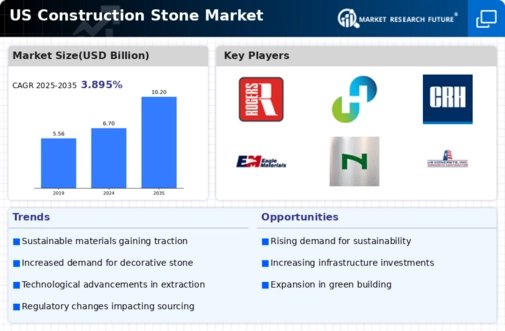Infrastructure Investment Surge
The construction stone market experiences a notable boost due to increased infrastructure investments across the United States. Government initiatives aimed at enhancing transportation networks, bridges, and public facilities are driving demand for construction stone. In 2025, federal and state budgets allocate approximately $1 trillion for infrastructure projects, which is expected to elevate the market's growth trajectory. This influx of funding not only stimulates the construction sector but also creates a ripple effect in the construction stone market, as materials are essential for these large-scale projects. The construction stone market is likely to benefit from this trend, as the need for durable and high-quality materials becomes paramount in meeting the demands of modern infrastructure.
Urbanization and Housing Demand
Rapid urbanization in the United States significantly influences the construction stone market. As more individuals migrate to urban areas, the demand for housing and commercial spaces escalates. In 2025, urban areas are projected to house over 80% of the US population, necessitating the construction of new residential and commercial buildings. This surge in construction activities directly correlates with an increased need for construction stone, which is a fundamental component in building materials. The construction stone market is poised to capitalize on this trend, as developers seek reliable and sustainable materials to meet the growing housing demands in urban centers.
Rising Demand for Aesthetic Appeal
The construction stone market is witnessing a growing trend towards aesthetic appeal in building materials. As consumers and developers increasingly prioritize design and visual impact, the demand for decorative stones and unique finishes is on the rise. In 2025, the market for decorative construction stone is projected to grow by 15%, driven by residential and commercial projects that emphasize aesthetics. The construction stone market must adapt to this shift, offering a diverse range of products that cater to the evolving tastes of architects and builders. This focus on aesthetics not only enhances property value but also encourages the use of high-quality materials in construction.
Regulatory Compliance and Standards
The construction stone market is increasingly shaped by stringent regulatory compliance and standards set by government agencies. In 2025, regulations concerning environmental sustainability and material quality are becoming more rigorous, compelling manufacturers to adapt their practices. Compliance with these standards not only ensures safety but also enhances the market's credibility. The construction stone market must navigate these regulations, which may lead to increased operational costs but also presents opportunities for innovation. Companies that prioritize compliance are likely to gain a competitive edge, as they can assure clients of the quality and sustainability of their materials.
Technological Integration in Production
Technological advancements in production processes are transforming the construction stone market. Innovations such as automated cutting and advanced quarrying techniques are enhancing efficiency and reducing waste. In 2025, the adoption of these technologies is expected to increase productivity by approximately 20%, allowing manufacturers to meet rising demand more effectively. The construction stone market is likely to see a shift towards more sustainable practices as technology enables better resource management. This integration not only improves operational efficiency but also aligns with the growing emphasis on sustainability within the construction sector.




















Leave a Comment